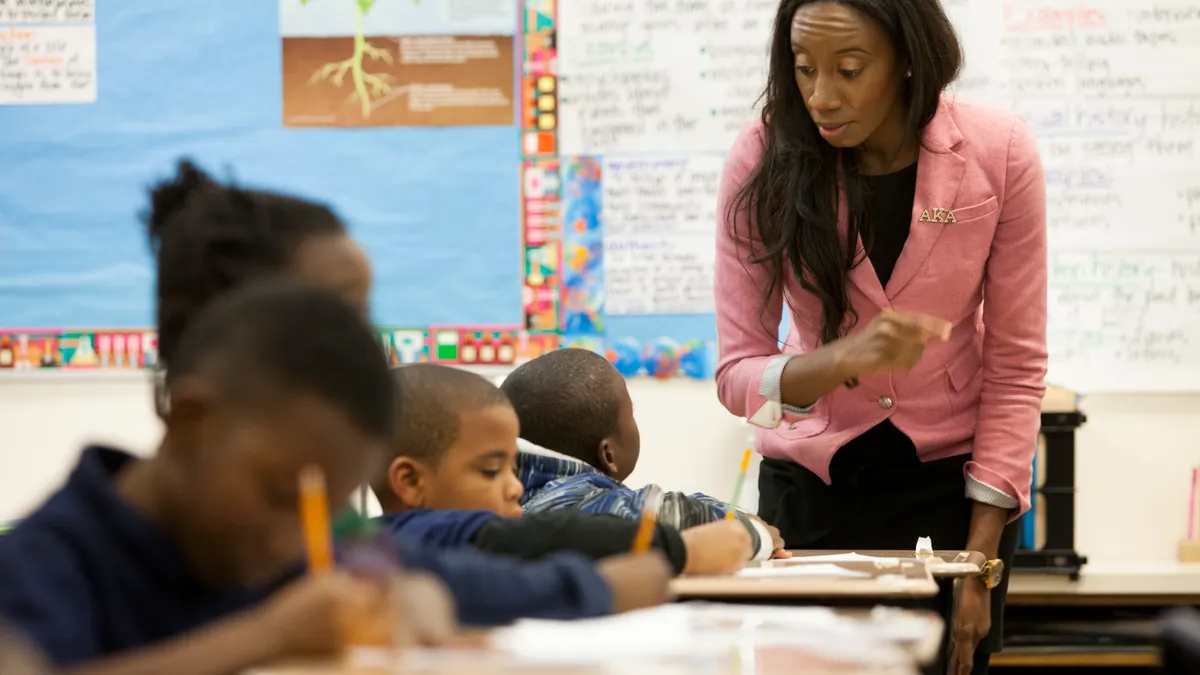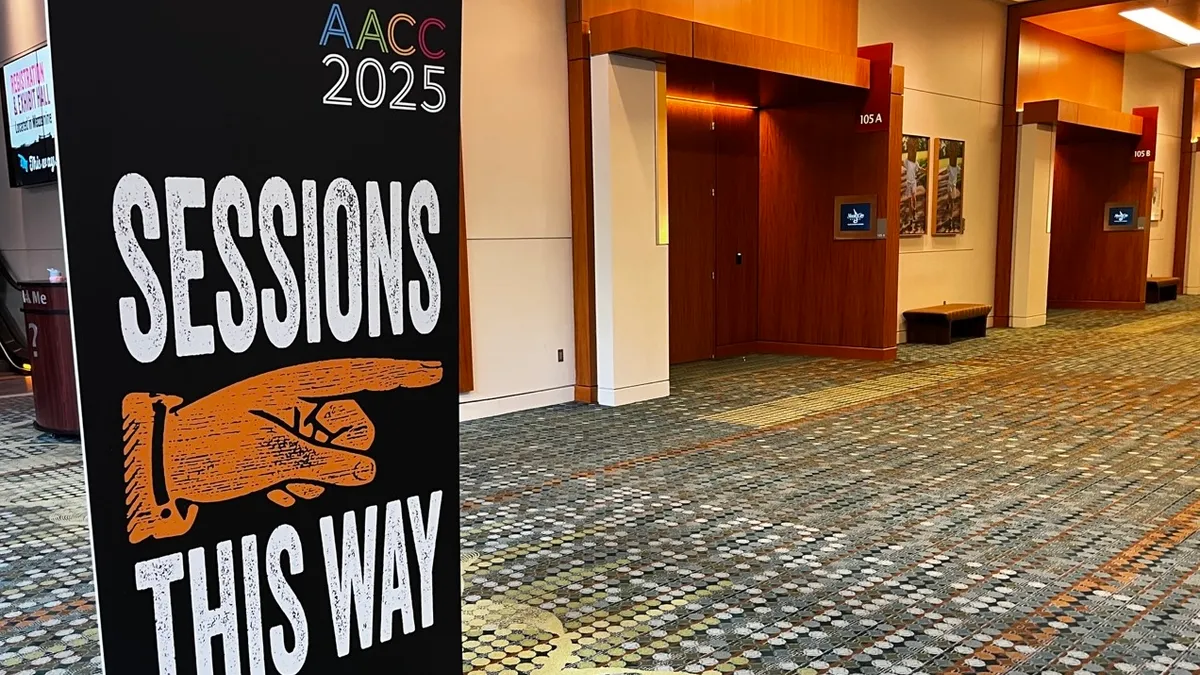The teacher shortage is growing in the U.S., but it's an uphill battle for many colleges looking to create more candidates.
More institutions are starting boutique programs, taking the time to build relationships with high school and even middle school students to expand the pipeline of future teachers. Although the individual programs may be successful, their collective impact has been small so far.
Meanwhile, the teacher deficit is growing. Since about 2012, the number of teachers needed in K-12 public schools has outpaced the number of available candidates. That gap has grown to a shortage of more than 110,000 teachers projected for the 2017-18 school year, compared to 20,000 in 2012-13. And with relatively few students from racial and ethnic minority groups considering teaching, the limited supply of newcomers can have broad-ranging implications.
In response, some colleges have started or accelerated programs to entice students to choose teaching and become certified. But with a strong job market, most have not been successful in increasing their education majors.
"It's the same phenomenon. Every single teacher prep program is 50% of what it was" two or three decades ago, said Catherine O'Callaghan, chair of the education and education psychology department at Western Connecticut State University.
WestConn, as it's known, was founded in the early 20th century to train teachers. Today, the school of more than 4,000 full-time undergraduates has just 182 students in various education majors in order to become teachers.
While that's a slight increase from four years ago, the school used to churn out 350 teacher candidates a year in the 1980s, O'Callaghan said.
Programs shrink
A host of factors prevents students from picking teaching as a possible career, ranging from low pay to a strong job market where work opportunities in other fields are plentiful. More than 70% of students responding to UCLA's latest annual survey of American freshmen say they attend college to "make more money." In the same survey, only 4.4% said they planned to become either elementary or secondary school teachers. Calculated against the 1.5 million students who start college full-time every year, that's just 66,000 potential teachers.
Most high school counselors don't have enough time to discuss the benefits of teaching when guiding students, said David Hawkins, the executive director for educational content and policy at the National Association for College Admission Counseling. Even schools with strong education programs promote their other offerings to prospective students, he said.
At Vanderbilt University's Peabody College, the number of undergraduates seeking teacher licensure slid from 181 students in 2015 to 161 students this year, said Kurt Brobeck, the school's director of communications.
"In Nashville, specifically, it's hard to purchase a house on a teacher's salary," said Teresa Dunleavy, an assistant professor of mathematics education at Peabody. She and her colleague, Heather Johnson, an associate professor of science education, recently earned a $1.2 million grant from the National Science Foundation to create a program to recruit and prepare STEM teachers to work in high-need school districts. The grant will help to pay more than half the cost of tuition for students seeking a master's degree in education at the school.
Outside of the grant, Peabody is studying ways to improve its teacher preparation program, the pair said. That includes trying to better explain the nuances of the profession to students, such as a teacher's role in conversations with parents and attending students' Individualized Education Program meetings.
Dunleavy started what she calls a "math teacher circle" where math teachers from all levels come together to solve complex math problems. "I wanted to create an area for people to get together and do math and not think about teaching," she said. "I want to bring the love back to mathematics."
Building a pipeline
Today's teacher shortage is not limited to STEM fields and high-need school districts, Dunleavy and O'Callaghan said. While it can be hard to land a job at an elementary school, O'Callaghan said there is a shortage for secondary English teachers in Connecticut, where public school teachers' salaries averaged more than $76,000 for the 2018-19 academic year.
One reason for the shortage is a lack of students from racial and ethnic minority groups considering the field. While students of color are now the majority in U.S. public K-12 schools, only 20% of their teachers are nonwhite. And just 2% of the country's some 3 million teachers are black men.
When she was a professor of education at Fayetteville State University, Gail Thompson started a program called Black Men Teaching, modeling it after Clemson University's Call Me MISTER program. Thompson, now a consultant who specializes in equity training, used a three-year grant from the W.K. Kellogg Foundation to visit high schools and middle schools to identify black boys who were interested in becoming teachers. Once accepted, the students received academic support and mentoring throughout high school and college.
"We talked up the benefits of becoming a teacher," she said. "They were constantly hearing why being a teacher is so great." The small program netted 14 students in 2014, its first year, she said.
Shartriya Collier-Stewart, associate dean of Nevada State College's School of Education, reaches out to high schools to find students from racial and ethnic minority groups who want to be teachers. She connects high school students with the college's education majors to discuss the craft of teaching while emphasizing to high schoolers that they could supplement their income by tutoring and selling lesson plans to fellow teachers.
While Nevada State's program is small, at 14 students, the college is building a 65,000-square-foot academic facility to help it attract more students and stem the state's teacher shortage. At the start of the school year, about 5% of teaching positions in the Clark County School District, which encompasses Las Vegas, had not been filled. The college's new building will include a speech pathology lab and an early childhood education center, according to local media reports.
While the college currently graduates 80 to 100 teacher candidates each year, Collier-Stewart said, "if we could double or quadruple that, that would be important" to help reduce the teacher shortage.
Education is one of the oldest majors at Atlanta's Spelman College, said Andrea Lewis, the chair of education at the historically black institution. But this year just 17 freshmen are pursuing it.
While that's a bump from the 11 students who graduated last spring, Lewis said several factors discourage minority students from majoring in teaching, including what she says can be tough job reviews and costly tests to be qualified to teach.
"Black men want to be able to provide for a family and be the head of a household," she said, speaking about the difficulties of attracting minorities to the profession. "A teacher salary cannot sustain a family." One in six teachers has a second job, while the rate is even higher for younger teachers, according to national estimates. That doesn't include non-teaching duties within the school, such as coaching and mentoring.
Whether initiatives to draw more students into teaching will be successful is uncertain.
When she visits colleges across the country through the Council for the Accreditation of Educator Preparation, O'Callaghan said she sees them trying to start new education programs and make current ones more robust.
But a lack of student interest, combined with budgetary issues for most colleges, is a double whammy that many institutions haven't been able to solve. "It's a real challenge," she said. Today's students have "a lot more options in different careers."




















